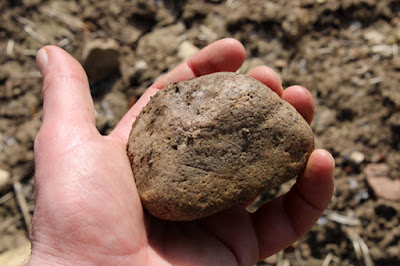 |
| A pebble of coarse grained Carboniferous sandstone |
Having spent an hour exploring St. Peter’s church and the historic buildings on Barker Hades Road in Letwell,- one of the most picturesque villages that I had seen in a long time, I was very curious about the red, limonite stained, sandy dolomitic limestone that I had been looking at.
Prising out a small piece of stone from the boundary wall opposite the Old Rectory with my Rodgers stainless steel knife, it felt sandy when I rubbed it with my thumb. When looking at it later with my hand lens, in addition to fine grains of angular quartz, I could see many small black flecks that I couldn't identify.
Continuing along Barker Hades Road to the village pond, where the surrounding red soil reminded me that the underlying bedrock here is the marl of the Edlington Formation, I then took a diversion from my planned route to take a photo of the dovecote, which I wanted to add to the British Listed Buildings website.
On the path to the dovecote, although not marked on the geological map, I noticed that the surrounding fields were liberally scattered with a wide variety of well rounded pebbles in various sizes, as well as others that were more angular in nature.
Many of these looked very similar to those that I had previously encountered around the Chesterfield Canal and Thorpe Salvin and when recently investigating the Quaternary geology around Kiveton Park, including coarse grained Carboniferous sandstone and vein quartz; however, others were not so easy to identify and they need an examination with a petrological microscope.
Looking down into the stream running alongside the path, although I could see no exposures of the red marl of the underlying Edlington Formation, the stream banks had occasional exposures of red clay full of pebbles and the streambed was covered in red sediment.
 |
| Exposures of red clay with pebbles in the stream bank |
















































